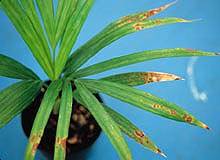C
cork144
since the uk water supply is flouradated and 66% of the american water supply is floruadated should we not have a topic where we combe for infomation on flourides affects on plants?
a picture of fluoride toxicity on a plant

I will try and compile a list here of problems surrounding fluoride ;
fluoride may be toxic to microbiological processes in soils
Yellowing of leaves / a bleaching of leaves,
slowed growth rate,
some pictures have shown a crisping of the outer edges of leaves,
found this out;
The most common micronutrient toxicity is caused by excess fluoride.
Fluoride toxicity. Typical injurious levels of fluoride ion causes marginal necrotic lesions along the edges of leaves.
Fluoride toxicity. Use of superphosphate or perlite amendments to containerized growth media can result in phytotoxic lever of fluoride ions. Marginal necrotic spots develop on affected plants
Removing fluoride from your water;
Ways to Remove Fluoride from Water
# Reverse Osmosis Filtration
This is used to purify several types of bottled water (not all), so some bottled waters are unfluoridated. Reverse osmosis systems are generally unaffordable for personal use.
# Activated Alumina Defluoridation Filter
These filters are used in locales where fluorosis is prevalent. They are relatively expensive (lowest price I saw was $30/filter) and require frequent replacement, but do offer an option for home water filtration.
# Distillation Filtration
There are commercially available distillation filters that can be purchased to remove fluoride from water. On a related note: When looking at bottled water, keep in mind that 'distilled water' does not imply that a product is suitable for drinking water and other undesirable impurities may be present.
These Do NOT Remove Fluoride
# Brita, Pur, and most other filters.
Some websites about fluoride removal state otherwise, but I checked the product descriptions on the companies' websites to confirm that fluoride is left in the water.
# Boiling Water
This will concentrate the fluoride rather than reduce it.
# Freezing Water
Freezing water does not affect the concentration of fluoride.
id also like to put a public health warning up here, flouride is damaging to your brain, it makes you placid, the chemical in prozac is a flouride compound.
http://www.fluoridealert.org/
a picture of fluoride toxicity on a plant
I will try and compile a list here of problems surrounding fluoride ;
fluoride may be toxic to microbiological processes in soils
Yellowing of leaves / a bleaching of leaves,
slowed growth rate,
some pictures have shown a crisping of the outer edges of leaves,
found this out;
The most common micronutrient toxicity is caused by excess fluoride.
Fluoride toxicity. Typical injurious levels of fluoride ion causes marginal necrotic lesions along the edges of leaves.
Fluoride toxicity. Use of superphosphate or perlite amendments to containerized growth media can result in phytotoxic lever of fluoride ions. Marginal necrotic spots develop on affected plants
Removing fluoride from your water;
Ways to Remove Fluoride from Water
# Reverse Osmosis Filtration
This is used to purify several types of bottled water (not all), so some bottled waters are unfluoridated. Reverse osmosis systems are generally unaffordable for personal use.
# Activated Alumina Defluoridation Filter
These filters are used in locales where fluorosis is prevalent. They are relatively expensive (lowest price I saw was $30/filter) and require frequent replacement, but do offer an option for home water filtration.
# Distillation Filtration
There are commercially available distillation filters that can be purchased to remove fluoride from water. On a related note: When looking at bottled water, keep in mind that 'distilled water' does not imply that a product is suitable for drinking water and other undesirable impurities may be present.
These Do NOT Remove Fluoride
# Brita, Pur, and most other filters.
Some websites about fluoride removal state otherwise, but I checked the product descriptions on the companies' websites to confirm that fluoride is left in the water.
# Boiling Water
This will concentrate the fluoride rather than reduce it.
# Freezing Water
Freezing water does not affect the concentration of fluoride.
id also like to put a public health warning up here, flouride is damaging to your brain, it makes you placid, the chemical in prozac is a flouride compound.
http://www.fluoridealert.org/
Last edited:


